History
VFP-62 was established in January 1949 as Composite Squadron SIX TWO (VC-62), nicknamed the Fighting Photos, and was equipped with Grumman F8F-2P Bearcat and Vought F4U-5P Corsair fighter aircraft converted to reconnaissance platforms. The first VC-62 detachment was assigned to Carrier Air Group 7 (CVG-7) aboard the aircraft carrier USS Leyte from September 1949 to January 1950 for a deployment to the Mediterranean Sea.
Detachments of the squadron operated from all Atlantic Fleet attack aircraft carriers based on the U.S. east coast. From September 1950 to February 1951, a VC-62 detachment also operated during the Korean War from the USS Leyte as part of CVG-3.
In 1951, the squadron converted to jet aircraft and was equipped with the McDonnell F2H-2P Banshee. On 2 July 1956, the squadron was redesignated Photographic Reconnaissance Squadron SIX TWO (VFP-62) and transitioned to the Grumman F9F-6P Cougar (later F9F-8P).
Renamed Light Photographic Squadron SIX TWO (VFP-62) in order to distinguish it from Heavy Photographic squadrons that were being established, the squadron received its first Vought F8U-1P Crusader aircraft in 1959, which were redesignated as the RF-8A in 1962. In 1966, these aircraft were upgraded to a new standard designated as the RF-8G.
VFP-62 is best known as the squadron that took the first low-level photos of the Soviet missile bases in Cuba during the Cuban Missile Crisis in October 1962. At the time, it was commanded by then-Commander William Ecker, USN. In 2000, the movie Thirteen Days (film), produced by Kevin Costner, showed the actions of Ecker and the other members of VFP-62 during the Cuban Missile Crisis.
From June 1966 to February 1967, VFP-62 Det 42 operated from the USS Franklin D. Roosevelt off Vietnam as part of CVW-1. VFP-62 was subsequently disestablished on 1 January 1968, with its role assumed by its Pacific Fleet sister squadron, VFP-63, also flying the RF-8G, and by several reconnaissance attack squadrons (RVAH) flying the North American RA-5C Vigilante.

The McDonnell F2H Banshee is a single-seat carrier-based jet fighter aircraft designed and produced by the American aircraft manufacturer McDonnell Aircraft. It was an early jet fighter operated by United States Navy and United States Marine Corps, as well as being the only jet-powered fighter to ever be deployed by the Royal Canadian Navy. The aircraft's name is derived from the banshee of Irish mythology.
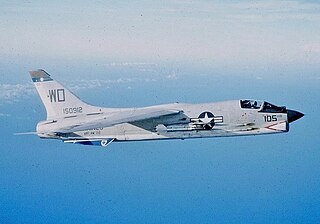
The Vought F-8 Crusader is a single-engine, supersonic, carrier-based air superiority jet aircraft designed and produced by the American aircraft manufacturer Vought. It was the last American fighter that had guns as the primary weapon, earning it the title "The Last of the Gunfighters".

The North American AJ Savage is an American carrier-based medium bomber built for the United States Navy by North American Aviation. The aircraft was designed shortly after World War II to carry atomic bombs and this meant that the bomber was the heaviest aircraft thus far designed to operate from an aircraft carrier. It was powered by two piston engines and a turbojet buried in the rear fuselage. The AJ-1 first became operational in 1950 and several were based in South Korea during 1953 as a deterrent against North Korea. Of the 140 built, plus three prototypes, 30 were reconnaissance aircraft. Inflight-refueling equipment was deployed on the Savage in the mid-1950s. The bomber was replaced by the Douglas A3D Skywarrior beginning in 1957. The type was used after its military service for some additional experiments including microgravity test flights and to test a new jet engine in the 1960s and 70s.

A carrier air wing is an operational naval aviation organization composed of several aircraft squadrons and detachments of various types of fixed-wing and rotary-wing aircraft. Organized, equipped and trained to conduct modern US Navy carrier air operations while embarked aboard aircraft carriers, the various squadrons in an air wing have different but complementary missions, and provide most of the striking power and electronic warfare capabilities of a carrier battle group (CVBG). While the CVBG term is still used by other nations, the CVBG in US parlance is now known as a carrier strike group (CSG).

Fighter Squadron 33 (VF-33) was an aviation unit of the United States Navy. Originally established on 11 October 1948 it was disestablished on 1 October 1993. It was the second U.S. Navy squadron to be designated VF-33.
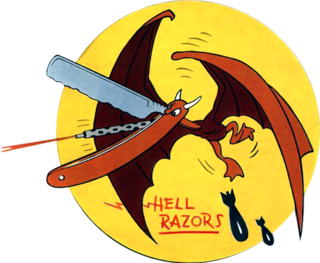
Attack Squadron 174 (VA-174) also known as the "Hellrazors" was a United States Navy attack squadron based at Naval Air Station Cecil Field, Florida, and were attached to Light Attack Wing One. It was commissioned from 1944 to 1988.

William Ecker was a United States Navy officer.

All Weather Fighter Squadron 3 was a designation which was used by two separate U.S. Navy aviation squadrons. The first squadron to use the designation was established as Composite Squadron THREE (VC-3) on 20 May 1943, was redesignated All Weather Fighter Squadron THREE on 1 July 1956 and was disestablished on 2 May 1958. The second squadron to use the designation was established as "Navy Air Training Unit-Pacific (NATUPAC)" on 22 May 1944, was redesignated "Night Development Squadron Pacific (NightDevRonPac)" on 6 April 1946, then "Fighter All Weather Training Unit Pacific (FAWTUPAC)" on 1 September 1948 and finally, on the same day as the first squadron designated VF(AW)-3 was disestablished, 2 May 1958, was redesignated "All Weather Fighter Squadron THREE (VF ". This second squadron to carry the VF -3 designation adopted the insignia and nickname "Blue Nemesis" from the first VF -3 and was the only U.S. Navy unit to be assigned to the North American Air Defense Command.
VC-10 Composite SquadronChallengers was a United States Navy aircraft squadron. It was originally known as the Mallards in 1943, but when assigned the F-8 Crusader the squadron pilots unofficially used the name "Challengers". The squadron was formally known as the Challengers from 1961 through 1993.

VA-106 was an Attack Squadron of the U.S. Navy. Originally established as Bomber-Fighter Squadron Seventeen (VBF-17) on 2 January 1945, it was redesignated Fighter Squadron Six B (VF-6B) on 15 November 1946, redesignated VF-62 on 28 July 1948, redesignated Attack Squadron 106 (VA-106) on 1 July 1955, it was disestablished on 7 November 1969. It was the second US Navy squadron to be designated VA-106.

Attack Squadron 72 (VA-72) was an aviation unit of the U.S. Navy. It was established as Bomber Fighter Squadron 18 (VBF-18) on 25 January 1945. The squadron was redesignated as Fighter Squadron 8A (VF-8A) on 15 November 1946, as VF-72 on 28 July 1948, and finally as VA-72 on 3 January 1956. It was disestablished on 30 June 1991.

VA-34, nicknamed the Blue Blasters, was an Attack Squadron of the U.S. Navy. The squadron was established as Fighter Squadron VF-20 on 15 October 1943, redesignated as VF-9A on 15 November 1946, as VF-91 on 12 August 1948, and as VF-34 on 15 February 1950. It was finally redesignated VA-34 on 1 July 1955. The squadron was disestablished on 1 June 1969. It was the second squadron to bear the VA-34 designation, the first one having been renamed VA-35 in 1950.

Attack Squadron TWELVE, also known as the "Flying Ubangis" or "Clinchers", was an attack squadron of the United States Navy active during the Cold War. From their home port at Naval Air Station Cecil Field in Florida, the squadron made more than thirty major overseas deployments aboard aircraft carriers, primarily flying A-4 Skyhawk and later the A-7E Corsair II, including two combat tours in the Vietnam War.
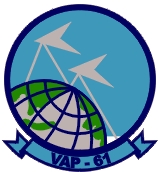
VAP-61 was a Heavy Photographic Squadron of the U.S. Navy. Originally established as VP-61 on 20 January 1951, it was redesignated VJ-61 on 5 March 1952. It was redesignated as VAP-61 in April 1956, redesignated as VCP-61 on 1 July 1959 and redesignated as VAP-61 on 1 July 1961. The squadron was disestablished on 1 July 1971.

VFP-63 was a Light Photographic Squadron of the U.S. Navy. Originally established as Composite Squadron Sixty-One (VC-61) on 20 January 1949, it was redesignated as Fighter Photographic Squadron (VFP-61) on 2 July 1956. Redesignated as Composite Photographic Squadron Sixty-Three (VCP-63) on 1 July 1959 and finally redesignated as Light Photographic Squadron Sixty-Three (VFP-63) on 1 July 1961. The squadron provided a detachment of reconnaissance planes for each of the Carrier Air Wings of the U.S. Pacific Fleet. The squadron was disestablished on 30 June 1982.
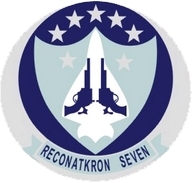
RVAH-7 was a reconnaissance attack (heavy) squadron of the U.S. Navy. Originally established as Composite Squadron Seven (VC-7) on 10 August 1950, it was redesignated as Heavy Attack Squadron Seven (VAH-7) on 1 November 1955 and was redesignated again as Reconnaissance Attack (Heavy) Squadron Seven (RVAH-7) on 1 December 1964. The squadron was disestablished on 28 September 1979.

RVAH-3 was a Reconnaissance Attack (Heavy) Squadron of the U.S. Navy that served as the Fleet Replacement Squadron (FRS) for the RVAH community. Originally established as Heavy Attack Squadron Three (VAH-3) on 15 June 1956, it was redesignated as Reconnaissance Attack (Heavy) Squadron Three (RVAH-3) on 1 July 1964. The squadron was disestablished on 17 August 1979.
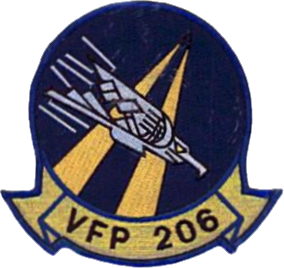
VFP-206 was a Light Photographic Squadron of the United States Navy Reserve established on 1 June 1970. The squadron was disestablished on 29 March 1987.

Marine Composite Reconnaissance Squadron 1 (VMCJ-1) was an aviation squadron of the United States Marine Corps that provided aerial photographic reconnaissance and electronic countermeasures is support of the Fleet Marine Force. The squadron was formed in 1958 with the merger of Marine Composite Squadron 1 (VMC-1) and Marine Photo Reconnaissance 1 (VMJ-1). The squadron's support to the Vietnam War began in 1964 flying off Yankee Station and ended with sorties in support of Operation Frequent Wind during the fall of Saigon. VMCJ-1 was decommissioned in 1975 as the Marine Corps further consolidated its aerial photo reconnaissance assets after the Vietnam War.






















